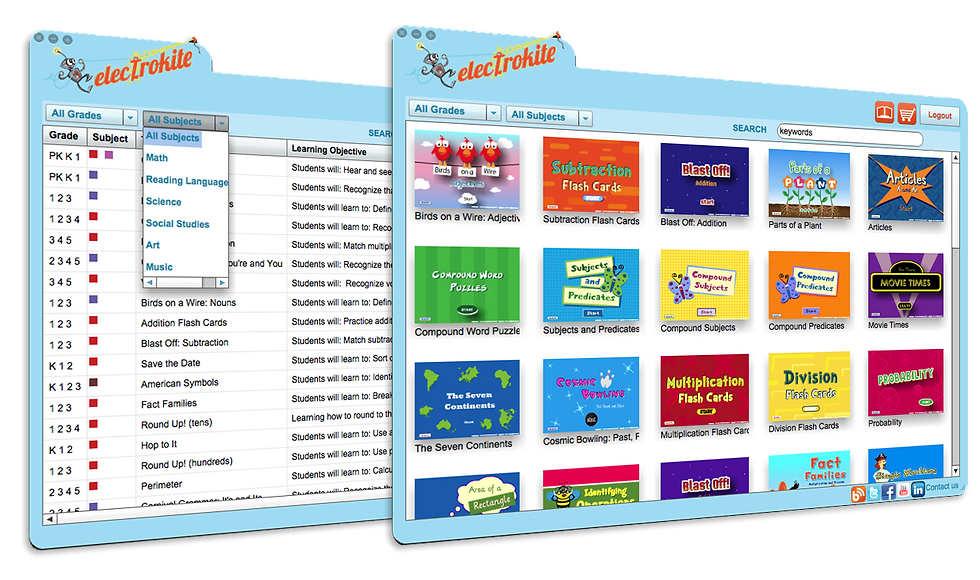
Edtech before it was cool:
how we built a digital learning ecosystem
As cofounder and creative director of Electrokite Interactive, I helped launch a comprehensive educational technology solution in 2011—when digital learning was still emerging. Our team created a curriculum of 100 interactive apps for Pre-K through Grade 5, all aligned to Common Core standards. To help educators navigate this expansive offering, we developed the ElectroGuide—a platform where teachers could easily discover apps, sorting by subject, grade, and standard, or by doing a keyword search.
The challenge
Build a scalable, standards-based edtech product that delivered real value to teachers and students—while gaining the trust of schools and investors—with a lean, cross-functional founding team.
My role
I led the brand identity and creative direction. I designed the conceptual model, wireframes, and high-fidelity UI for the ElectroGuide, and co-led the design and illustration of our curriculum.
I also helped define our go-to-market strategy, launching across web, iOS, and Android to reach both schools and families.
Team
Creative director / cofounder
Ellie V
CTO / cofounder
Tommy Reilly
Curriculum / design / cofounder
Kerrie Gallagher
Business development / cofounder
Mary Sparks
Instructional design
Kerrie Gallagher, Maria O'Meara
Illustration
Lauren Delaney, Kerrie Gallagher, Ellie V
Web and database development
Paul Yeaton, Joe Wizda
Software engineering
Tommy Reilly, Kerrie Gallagher
Photo research / marketing
Gayna Hoffman
Advisors
Anita Brearton, Paris Wallace

Business and design strategy
Having worked on edtech before, we knew the core challenges: poor discovery tools, clunky interfaces, and uninspiring content. We addressed them by building tight feedback loops between educators, designers, and developers, ensuring every app was instructionally grounded and visually engaging.
Agile sprints helped us quickly turn learning goals into interactive experiences. We built a cohesive brand system that unified our apps, platform, and marketing.
To drive adoption, we launched a responsive website, developed targeted outreach via a user database, and created onboarding tools like webinars and tutorials—supporting both classroom and consumer growth.
The brand
The brand name, Electrokite, and our mascot, a kite-flying robot, emerged from one inspired brainstorming session. We brought the EK Bot to life with an illustrator, animating it to guide learners with narration and multisensory cues. It became the face of our brand—playful, relatable, and consistently present across every touchpoint.

The ElectroGuide in action
A look at our PK–5 learning platform and apps

Our desktop learning platform worked online and offline—crucial for schools with limited internet. Teachers could sort by subject and grade; search by common core standard, subject, keywords, or grade; preview app details; and launch apps, which then cached for offline use.
Our 100-app curriculum spanned topics from phonics to simple machines. Each app mixed illustration, music, and game-like mechanics to support active, multimodal learning. Originally built for desktops and whiteboards, the apps were later converted for iOS and Android to reach more users.
“I have so much that I should be doing, but once I clicked on one application, I couldn’t stop.”
—2nd Grade Teacher from Pennsylvania

Outreach and onboarding
We launched a freemium model through our marketing site, allowing teachers to sign up for a trial of the ElectroGuide and curriculum. Many converted to paid subscribers.
To scale adoption, we hosted webinars for thousands of educators and administrators across the US—demonstrating our tools, answering questions, and supporting implementation.



Impact



One of the best experiences we had was going into classrooms and seeing the kids figure out the interface and dive into the apps and worksheets. The kids would be instructing the teachers how to use our platform and apps! We got to see kids with all different learning styles find magic in our curriculum. I led a dance to the song I wrote with one of our editors, "Left and Right," that was meant to teach kids left and right through physical movement and multisensory inputs.
As adoption cycles in schools proved lengthy, we pivoted to focus on mobile distribution. Converting apps to iOS and Android allowed us to reach a wider audience and maintain momentum.
The experience I got from my work with Electrokite in business development, product development, and team collaboration have influenced my insights and decisions every day.

